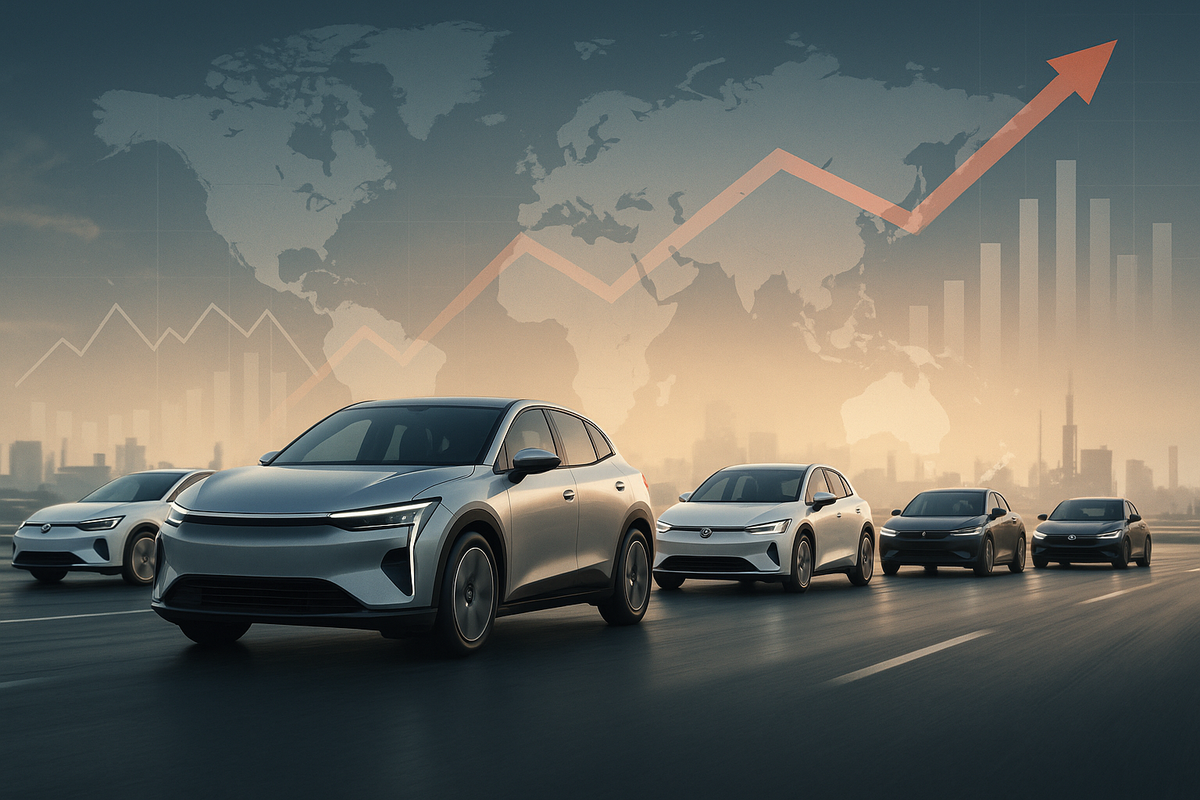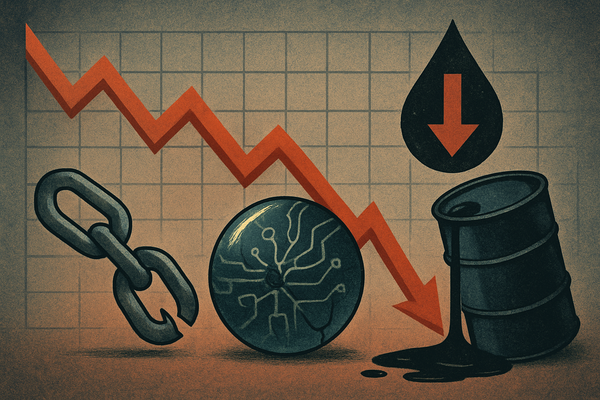Tesla vs. The World: Navigating Intense Competition and Shifting Global EV Market Share

The once seemingly unassailable dominance of Tesla (NASDAQ: TSLA) in the global electric vehicle (EV) market is facing its most significant challenge yet. A confluence of factors, including the aggressive resurgence of traditional automakers and the rapid ascent of Chinese manufacturers, has plunged the market into a fiercely competitive era, directly impacting Tesla's long-held leadership. This escalating rivalry is not just a commercial skirmish; it signifies a profound reordering of the automotive industry's power dynamics, with implications for innovation, pricing, and consumer choice worldwide.
Recent data paints a clear picture of this seismic shift: Tesla's market share is noticeably eroding in key regions, and perhaps most strikingly, Chinese EV behemoth BYD (HKG: 1211) has begun to outpace Tesla in crucial European sales. This evolving landscape compels a deeper examination of the forces at play, the immediate consequences for industry titans, and what this intensified battle for EV supremacy means for the future of sustainable transportation.
The EV Throne Contested: Tesla's Grip Loosens Amidst Global Onslaught
The narrative of Tesla as the undisputed pioneer and reigning monarch of the EV world is rapidly giving way to a more complex reality. For years, the company enjoyed a near-monopoly in many markets, benefitting from its early mover advantage and groundbreaking technology. However, that era is definitively drawing to a close as formidable challengers emerge from every corner of the automotive spectrum.
Traditional automakers, initially slow to embrace the electric revolution, have now fully committed their vast resources and manufacturing prowess to the EV transition. Giants like General Motors (NYSE: GM), Ford (NYSE: F), and Volkswagen (XTRA: VOW3) are leveraging their established dealer networks, extensive supply chains, and deep-seated brand loyalty to flood the market with a diverse array of EV models. Ford, for instance, aims to produce over 600,000 EVs annually by late 2024, while Volkswagen's ID.4 has seen considerable sales growth, partly fueled by aggressive incentives. These legacy players are not just playing catch-up; they are actively competing on features, quality, and increasingly, price, directly challenging Tesla's once-unique value proposition.
However, the most formidable and rapidly growing threat emanates from China. Manufacturers like BYD, Nio (NYSE: NIO), Xpeng (NYSE: XPEV), and Li Auto (NASDAQ: LI) are not merely participants; they are reshaping the global EV landscape with aggressive pricing, rapid innovation, and a keen understanding of localized market preferences. BYD, in particular, has emerged as a global powerhouse, vertically integrated with its own battery production, enabling significant cost advantages. By the end of 2023, BYD had already surpassed Tesla in overall EV sales (including plug-in hybrids), securing approximately 18% of the global market share compared to Tesla's 15%. This success is heavily underpinned by its dominant position in China, which accounts for 60% of the world's EV market, and its increasingly aggressive international expansion.
The impact on Tesla's market share has been stark and immediate. In the U.S. market, Tesla's share plummeted to 38% in August 2025, marking the first time it has fallen below the 40% threshold since October 2017. This represents a significant erosion from its long-standing position of over 50% and even 80% in earlier years. Globally, Tesla's sales were down roughly 10% in 2025 compared to its peak in 2023. European sales saw a dramatic decline of up to 40%, and even in its once-stronghold of China, sales were down about 5-6%. A watershed moment occurred in April 2025 when BYD officially surpassed Tesla in European battery-electric vehicle sales, registering 7,231 units compared to Tesla's 7,165. This achievement by BYD, which only significantly expanded into Europe in late 2022, represents a staggering 359% year-on-year increase, directly contrasting with Tesla's 49% year-on-year drop in the same period. This trend underscores not just intensifying competition, but a fundamental shift in market leadership in key regions. The impending expiration of the $7,500 federal tax credit in the U.S. at the end of September 2025 is expected to further intensify competition in Q4, potentially leading to a sales slowdown after a Q3 rush.
Shifting Fortunes: Who Wins and Loses in the Electric Race
The current upheaval in the EV market is redrawing the lines of competition, creating clear winners and losers among the industry's titans and newcomers alike. For investors and consumers, understanding these shifts is crucial to navigating the evolving landscape.
At the forefront of the "winners" circle stands BYD (HKG: 1211) and its cohort of aggressive Chinese EV manufacturers. BYD's vertically integrated supply chain, encompassing everything from battery production to final assembly, grants it a significant cost advantage. This allows the company to engage in fierce price competition while maintaining robust profitability, leading to a dominant 31.4% market share in China in 2024 and ambitious plans to double overseas sales to over 800,000 units in 2025. Other Chinese players like Nio (NYSE: NIO), Xpeng (NYSE: XPEV), and Xiaomi (HKG: 1810) (through its rapidly successful Xiaomi EV) are also demonstrating strong delivery growth and innovative product development, rapidly gaining ground. These companies benefit from swift product cycles and government support, positioning them for continued expansion, especially as they look to international markets to offset domestic overcapacity. Their stock performance, while subject to market volatility, often reflects their strong growth trajectories and expanding global footprint.
Meanwhile, traditional automakers that have strategically invested in their EV divisions and shown adaptability are also emerging as winners. General Motors (NYSE: GM), for instance, saw its EV sales surge by 111% in Q2 2025, capturing a 16% market share in the U.S. with popular models like the Chevrolet Equinox EV. GM's ambition to reach 1 million EV production capacity by 2025 and its focus on North American supply chains demonstrate a robust strategy. Ford (NYSE: F) is similarly introducing more affordable EV models to directly counter Tesla's price cuts. These companies are leveraging their established manufacturing scale and brand recognition, often diversifying their offerings to include hybrids and catering to a broader spectrum of consumer preferences, which is proving crucial in a market where pure-EV adoption can be uneven. Their stock performance is increasingly tied to the successful execution of these electric transitions.
Conversely, Tesla (NASDAQ: TSLA) finds itself in the uncomfortable position of a "loser" in this intensifying competitive environment. The company's U.S. market share has plummeted from 60% in 2020 to 38% in 2024, falling below 50% in early 2025. Globally, Tesla's sales decreased by 10% in 2025, with dramatic drops in Europe and China. This has had a direct impact on its stock, which has seen significant declines, reflecting diminished investor confidence. Tesla has resorted to aggressive price cuts on its Model 3 and Model Y, pushing prices into the mid-$30,000 range after federal credits. While this stimulates demand, it has come at the expense of profitability, as evidenced by a 71% drop in net income in Q1 2025. The company is now compelled to design cheaper models and faces pressure to re-evaluate its strategic direction amidst fierce competition and public scrutiny of its CEO.
The market is also proving challenging for smaller, underfunded EV startups, with Fisker (OTC: FSRN) being a recent high-profile example of a company that could not survive the increasing price wars and high development costs. Many emerging EV players have seen their market capitalization decline and are missing sales targets. Similarly, traditional automakers that have been slow to adapt, or those that have delayed or scaled back their EV goals, risk being left behind. Companies like Toyota (NYSE: TM), which postponed plans to build EVs in the U.S. and shifted its 2026 EV production target, and Volvo (STO: VOLV B), anticipating a challenging 2025 due to slower EV adoption, highlight the pitfalls of a cautious or reactive approach. Their stock performance can suffer as investors become wary of their long-term competitiveness in an electrifying market. Finally, the broader EV ecosystem, including battery manufacturers like CATL and SVOLT Energy Technology, and charging infrastructure providers like Blink Charging (NASDAQ: BLNK), represent a mixed bag. While the overall growth of the EV market generally benefits these sectors, individual companies face their own competitive pressures and technological shifts.
Industry Impact and Broader Implications: A New Era of Automotive Manufacturing
The intensifying competition in the global EV market, characterized by Tesla's diminishing lead and the rapid rise of Asian manufacturers, particularly BYD, signals more than just a redistribution of market share. It marks the advent of a new era in automotive manufacturing and consumer choice, with profound implications that extend across industry trends, regulatory frameworks, and global economic dynamics.
This event fits squarely into several broader industry trends. Firstly, it underscores the rapid maturation of the EV market from a niche segment dominated by a single innovator to a highly competitive, multi-polar landscape. This maturation is driving unprecedented levels of investment in research and development, particularly in battery technology, charging infrastructure, and advanced driver-assistance systems. The focus is shifting from simply electrifying vehicles to optimizing every aspect of the EV ecosystem for cost-efficiency, performance, and user experience. Secondly, it highlights the undeniable shift of manufacturing power eastward, with China emerging not just as the largest consumer market but also as a global manufacturing and innovation hub for EVs. Chinese manufacturers benefit from robust domestic supply chains, significant government support, and aggressive pricing strategies, which are now exerting immense pressure on Western automakers both at home and abroad.
The ripple effects on competitors and partners are substantial. For traditional automakers, the pressure to accelerate their EV transition is now more acute than ever. Those that hesitated or scaled back their ambitions, like Toyota (NYSE: TM) with its adjusted EV production targets, risk losing further ground. The success of players like General Motors (NYSE: GM) and Ford (NYSE: F), who have committed heavily to their EV platforms and diversified their offerings (including hybrids), demonstrates the necessity of a proactive and flexible strategy. Furthermore, the aggressive pricing from Chinese manufacturers is forcing a re-evaluation of production costs and efficiency across the board, pushing all players to innovate or risk being undercut. Partnerships within the industry are also evolving; for example, the widespread adoption of Tesla's North American Charging Standard (NACS) by other automakers (e.g., GM, Ford, Rivian (NASDAQ: RIVN)) despite the competitive landscape, illustrates the strategic alliances forged out of practical necessity.
Regulatory and policy implications are also coming into sharper focus. Governments worldwide are grappling with the balance between fostering domestic EV industries and maintaining open markets. The surge of affordable Chinese EVs into Europe has already sparked discussions about potential tariffs and trade protectionist measures, similar to historical precedents in other manufacturing sectors. In the U.S., the upcoming expiration of the $7,500 federal tax credit for EVs at the end of September 2025 is a critical policy shift. While it drove a rush in Q3 sales, its removal is expected to intensify competition further in Q4, potentially dampening overall EV sales unless manufacturers can absorb the cost or consumers are willing to pay more. This creates a delicate balancing act for policymakers aiming to accelerate EV adoption while ensuring fair competition and consumer affordability. Historically, similar shifts in the automotive industry, such as the rise of Japanese automakers in the 1970s and 80s or German manufacturers in the post-war era, have led to significant restructuring of global supply chains and a re-evaluation of national industrial policies.
What Comes Next: Navigating a Volatile Electric Future
The path forward for Tesla and the broader EV market is fraught with both challenges and opportunities, demanding strategic pivots and rapid adaptation from all players. In the short term, the intensifying price wars, particularly in China and Europe, are likely to continue, putting further pressure on profit margins across the industry. The post-subsidy environment in the U.S. after September 2025 will test the true demand for EVs at higher price points, potentially leading to a temporary slowdown in sales, followed by an even fiercer battle for market share.
For Tesla (NASDAQ: TSLA), the immediate future necessitates a renewed focus on its core automotive business. The company must accelerate the introduction of new, more affordable models to compete with the rapidly expanding and competitively priced offerings from BYD (HKG: 1211) and other rivals. Strategic diversification into ambitious projects like humanoid robots and robotaxis, while promising for the long term, may need to be balanced with immediate efforts to bolster its vehicle lineup and re-capture market momentum. Tesla's ability to innovate beyond its current Model 3 and Model Y, which are showing signs of an aging product cycle in a fast-evolving market, will be critical. This could include advancements in battery technology that offer greater range or lower costs, or entirely new vehicle segments.
Looking long-term, the global EV market is expected to continue its robust growth trajectory, but with a significantly more diversified landscape of manufacturers. Chinese OEMs are poised for sustained international expansion, likely establishing more overseas production facilities to circumvent potential tariffs and localize their offerings. This geographic diversification will be a key strategic pivot for them. Traditional automakers, having committed billions to electrification, will need to continuously refine their EV platforms, enhance their software capabilities, and improve charging infrastructure to deliver a seamless customer experience that can rival the tech-forward approaches of their competitors. Market opportunities will emerge in segments currently underserved by existing EV models, such as affordable small urban vehicles or specialized commercial EVs. Challenges will include managing complex global supply chains, securing access to critical raw materials, and navigating varying regulatory environments across different countries.
Potential scenarios range from a continued "race to the bottom" on pricing, leading to further consolidation and bankruptcies among weaker players, to a more mature market where differentiation comes from advanced technology, brand loyalty, and superior charging ecosystems. The outcome will largely depend on each company's ability to innovate rapidly, manage costs effectively, and understand the diverse needs of regional markets. The next few years will undoubtedly see strategic alliances, technology sharing, and perhaps even unexpected mergers and acquisitions as companies seek to bolster their positions in this volatile yet transformative industry.
Conclusion: The Dawn of a Decentralized Electric Future
The narrative of "Tesla vs. The World" has evolved dramatically. No longer is it a lone disruptor against entrenched giants, but rather a dynamic, multi-faceted competition where innovation, efficiency, and global reach are paramount. The recent shifts, highlighted by Tesla's (NASDAQ: TSLA) declining market share in key regions and the ascendancy of BYD (HKG: 1211) and other Chinese manufacturers, signal a fundamental restructuring of the global automotive industry. This is not merely a temporary blip but rather the dawn of a more decentralized and fiercely competitive electric future.
The key takeaways from this transformation are clear: the era of single-company dominance in the EV market is over. Consumers are now presented with an unprecedented array of choices, fostering an environment where innovation thrives and pricing becomes more competitive. This intensified competition is forcing all players to re-evaluate their strategies, accelerate their R&D, and prioritize cost efficiency. The geopolitical implications, particularly concerning trade and manufacturing hubs, will also continue to shape the industry, potentially leading to more regionalized supply chains and distinct market ecosystems.
Moving forward, the market will undoubtedly remain highly dynamic. Investors should closely watch for strategic pivots from major players, especially Tesla's response to its eroding market share through new model introductions and enhanced cost management. The continued global expansion of Chinese EV brands, their ability to establish manufacturing footprints outside of China, and their impact on traditional automakers' profitability will also be critical indicators. Furthermore, the development of next-generation battery technologies, advancements in autonomous driving, and the build-out of robust charging infrastructure will play pivotal roles in determining long-term winners. The electric vehicle revolution is far from over; it's simply entering its most exciting and unpredictable chapter yet.



